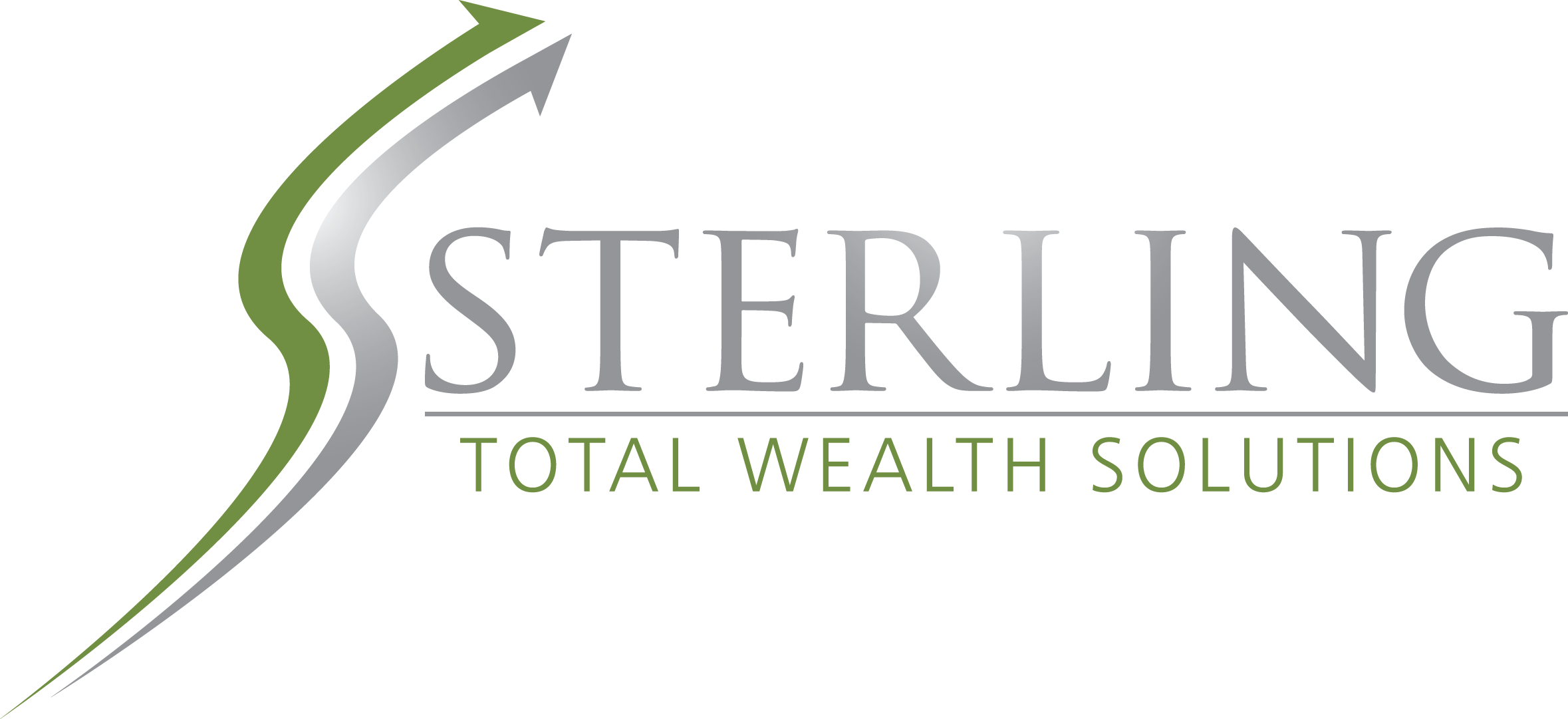In this Q3 recap: U.S. economic growth slows in the face of Delta variant headwind. Europe’s economic outlook remains positive. Stocks retreat from record highs; confront a bevy of challenges.
Quarterly Economic Update
A review of Q3 2021 | Presented by Sterling Total Wealth Solutions
THE QUARTER IN BRIEF
Overcoming rising Delta variant infections, a slowing economic expansion, and growing inflation worries, stocks raced higher through the course of the first two months of the third quarter, propelled by strong corporate earnings, the absence of compelling investment alternatives to stocks, and a “buy on the dip” investor mentality. Investors, however, turned more cautious in September, wary of the season’s rocky reputation, persistently high levels of COVID-19 cases, the length of time that the market has gone without a meaningful retreat, and the fiscal and tax policies under discussion in Washington, D.C.
Amid this caution and absent any positive catalysts, September turned volatile, with stocks retracing their earlier gains as seasonal weakness was exacerbated by the mounting financial difficulties of a debt-laden, large property developer in China and rising bond yields.
Stocks steadied briefly following a Federal Reserve announcement that its bond buying would continue, with tapering of monthly purchases likely beginning in November and extending into mid-2022. However, a surge in bond yields in the closing week of the quarter unsettled investors and led to steep declines, especially in the technology and other high growth stocks. (Higher interest rates decrease the value of future cash flow, often resulting in lower current stock price valuations.)
In the end, September erased the gains built over the previous two months, leaving major indices largely flat for the third quarter.
Investors saw another quarter of exceptional corporate earnings growth. Second-quarter earnings exceeded Wall Street estimates for 87% of the companies comprising the S&P 500 index. Anticipating continued strength in earnings growth, market analysts have increased earnings estimates by 3.7%, expecting that the earnings growth rate will come in at 27.9% for the third quarter. If these estimates are realized, this would represent the third highest year-over-year earnings growth rate in over a decade.1,2
THE U.S. ECONOMY
The momentum of the U.S. economic recovery slowed in the third quarter as a surge of Delta variant infections led to a deceleration in economic activity in industries such as travel, restaurants, and tourism. Economic expansion was further affected by supply bottlenecks and labor shortages. These supply bottlenecks were felt in multiple ways, from semiconductor chip shortages that limited auto production to delays of import deliveries from abroad due to factory and port closures in a number of Asian countries. Home sales were constrained by low inventory.
There were several economic sectors that continued their strong growth in the third quarter. These included manufacturing, transportation, non-financial services, and residential real estate.
Labor markets improved over the course of the last three months to the degree that employers were having difficulty finding workers. The Federal Reserve Bank ascribed a range of reasons for the worker shortage, including increased turnover, early retirements, childcare needs, challenges in negotiating job offers, and enhanced unemployment benefits.3
One consequence of this labor shortage has been an acceleration in wage gains, which may hold the potential for lower future corporate profits (if companies find that they are unable to pass on the higher cost) and higher inflation, as increased wages raise the costs of products and services.
Supply shortages, rising transportation costs, and wage increases have combined to create price pressures that have led to higher consumer costs in recent months. Reflecting these inflationary pressures were an 8.3% year-over-year jump in producer prices in August and a 5.3% 12-month increase in consumer prices.4,5
The degree to which economic growth may have slowed in the third quarter won’t be known until October’s release of the Q3 Gross Domestic Product (GDP) report. However, according to the Federal Reserve Bank of Atlanta, which tracks economic data in real time, their model is indicating a 3.2% annualized real rate of GDP growth in the third quarter, a sharp retreat from its model’s prediction of 5.3% on September 1.6
The Federal Open Market Committee’s economic projections issued in September also reflect a more cautious view of the economy in the near-term. GDP growth projections for 2021 were revised lower from June estimates, from 7.0% to 5.9%, while inflation estimates jumped from 3.4% to 4.2%.7
After plunging in August to near all-time lows, consumer sentiment steadied in September. Nonetheless, consumers are entering the final quarter of the year with a bleaker outlook due to heightened concerns over inflation.8
GLOBAL ECONOMIC HEALTH
The outlook for economic growth in European Union (EU) countries grew more positive with widening vaccinations, an improving health situation, and the easing of lockdown measures. The European Commission expects that output will return to pre-crisis levels by the fourth quarter of 2021. GDP growth estimates were lifted to 4.8% for 2021, while 2022 growth is expected to be 4.5%. Inflation estimates were raised to 2.2% for 2021 and 1.6% in 2022.9
The economic momentum that the United Kingdom enjoyed in the second quarter appears to be abating, owing to a resurgence in COVID-19 infections, staff shortages, kinks in the global supply chain, and continuing trade tensions with the EU. Nevertheless, the U.K. economy is projected to post a 6.6% growth rate for 2021 and a 5.5% expansion in 2022.10
After recording two successive quarters of strong economic growth, China’s economy is showing signs of slowing down. Flooding, higher input prices, and a surge in COVID-19 infections have all weighed heavily. A regulatory crackdown on a number of industries did nothing to improve conditions on the ground. It’s estimated that China will end the year with GDP growth rate of 8.5%, with a drop-off in 2022 to 5.5%.11
Despite a pick-up in the pace of vaccinations, the Bank of Japan pared its economic growth estimate to 3.8% from 4.0% for its fiscal year ending in March 2022, though it raised its estimate for the following year to 2.7%, from 2.4%. Encouragingly, Japan announced in late September that it would be lifting the coronavirus state of emergency that was in place since April 2021. Finally, it’s unclear what the impact may be of the decision by Prime Minister Suga not to seek reelection, but it has created an overhang of political uncertainty.12
The MSCI-EAFE Index, which tracks developed overseas markets, slipped 1.03% in Q3, while emerging markets, as measured by the MSCI-EM (Emerging Markets) Index, plunged 8.84%.13
TIP OF THE QUARTER

How financially literate are your children? Encourage them to read up on investing and money matters before they turn 18.
LOOKING BACK, LOOKING FORWARD
The third quarter was a reminder of how difficult it is to project the future amid a global pandemic. Investors entered July increasingly optimistic about an acceleration of the economic recovery, the prospect of rising vaccination rates, the reopening of schools, an easing in labor shortages, and a return to the office. By September, with the Delta variant lingering, employers delayed their plans for a return to the office, some mask mandates were reinstituted, and consumers pulled back on spending and travel.
Despite the deceleration in economic expansion, markets managed to climb to new record highs through most of the third quarter, though they stumbled in September.
If the market is to add to its year-to-date gains in the fourth quarter, it will need to climb a wall of worry. The worries include the expected start of tapering, global central bank tightening, fiscal and tax policy uncertainties, Covid infection levels, inflation, and whether corporate earnings can continue to impress in the wake of this quarter’s economic slowdown.
With the Federal Reserve’s September announcement that it may be set to begin tapering, the Fed joins a growing number of global central banks that have begun winding down the accommodative monetary policies that were put in place in response to the pandemic.
Of course, the pace of monetary tightening may be dictated, in part, by the prevalence of Delta variant infections over the course of the fourth quarter, as well as the state of labor market recovery, which continues to be prioritized over inflation by the Fed.
Inflation has touched levels not seen in over 40 years. Supply chain constraints continue to be a major factor in higher prices for businesses and, in turn, consumers. Especially troubling is that these bottlenecks may last for another year or longer. For now, the credit and equity markets seem to agree with Fed Chair Jerome Powell’s argument that inflation is transitory.
The question for investors is whether the markets will continue to accept that inflation is a transitory phenomenon should price pressures continue to rise through the fourth quarter.
While Washington may have been a tailwind for the market since hitting pandemic lows, it may turn out to be a headwind in the months ahead. Investors are wary of the impact on investments and corporate profits included in the proposed infrastructure plan and the new, higher taxes under discussion to pay for such spending.
Lastly, corporate profits and sales have exceeded market expectations in recent quarters, laying the foundation for the markets to move higher. As earnings are reported over the course of October and November, American businesses will need to once again show earnings growth that not only supports current price levels but also helps provide the rationale for higher valuations.
It’s a formidable wall to climb. Still, many of the conditions for continued stock market strength remain in place, specifically, a financially healthy consumer, an accommodative monetary policy (the Fed is not expected to hike rates until late 2022), strong corporate earnings, healthy economic expansion, and improving corporate cash balances.
|
MARKET INDEX |
Y-T-D CHANGE |
Q3 CHANGE |
Q2 CHANGE |
|
DJIA |
+10.58 |
-1.91 |
+4.61 |
|
NASDAQ |
+12.11 |
-0.38 |
+9.49 |
|
S&P 500 |
+14.68 |
+0.23 |
+8.17 |
|
BOND YIELD |
9/30 RATE |
1 MO AGO |
1 YR AGO |
|
10 YR TREASURY |
1.53% |
1.29% |
0.68% |
Sources: Wall Street Journal, September 30, 2021, Treasury.gov (Bond Yield)
The market indexes discussed are unmanaged and generally considered representative of their respective markets. Individuals cannot directly invest in unmanaged indexes. Past performance does not guarantee future results. U.S. Treasury Notes are guaranteed by the federal government as to the timely payment of principal and interest. However, if you sell a Treasury Note prior to maturity, it may be worth more or less than the original price paid.
QUOTE OF THE QUARTER

“I sometimes think we consider too much the good luck of the early bird and not enough the bad luck of the early worm.”
FRANKLIN DELANO ROOSEVELT
Securities offered through Registered Representatives of Cambridge Investment Research, Inc., a Broker/Dealer, Member FINRA/SIPC. Advisory services offered through Cambridge Investment Research Advisors, Inc., a Registered Investment Advisor. Sterling Total Wealth Solutions and Cambridge are not affiliated.
To learn more about Sterling Total Wealth Solutions, visit us on the web at www.sterlingtotalwealthsolutions.com
Know someone who could use information like this?
Please feel free send us their contact information via phone or email. (Don’t worry – we’ll
request their permission before adding them to our mailing list.)
This material was prepared by MarketingPro, Inc., and does not necessarily represent the views of the presenting party, nor their affiliates. The information herein has been derived from sources believed to be accurate. Please note – investing involves risk, and past performance is no guarantee of future results. Investments will fluctuate and when redeemed may be worth more or less than when originally invested. This information should not be construed as investment, tax or legal advice and may not be relied on for the purpose of avoiding any Federal tax penalty. This is neither a solicitation nor recommendation to purchase or sell any investment or insurance product or service, and should not be relied upon as such. All market indices discussed are unmanaged and are not illustrative of any particular investment. Indices do not incur management fees, costs, or expenses. Investors cannot invest directly in indices. All economic and performance data is historical and not indicative of future results. The Dow Jones Industrial Average is a price-weighted index of 30 actively traded blue-chip stocks. The NASDAQ Composite Index is a market-weighted index of all over-the-counter common stocks traded on the National Association of Securities Dealers Automated Quotation System. The Standard & Poor’s 500 (S&P 500) is a market-cap weighted index composed of the common stocks of 500 leading companies in leading industries of the U.S. economy. NYSE Group, Inc. (NYSE:NYX) operates two securities exchanges: the New York Stock Exchange (the “NYSE”) and NYSE Arca (formerly known as the Archipelago Exchange, or ArcaEx®, and the Pacific Exchange). NYSE Group is a leading provider of securities listing, trading and market data products and services. The New York Mercantile Exchange, Inc. (NYMEX) is the world’s largest physical commodity futures exchange and the preeminent trading forum for energy and precious metals, with trading conducted through two divisions – the NYMEX Division, home to the energy, platinum, and palladium markets, and the COMEX Division, on which all other metals trade. The CAC-40 Index is a narrow-based, modified capitalization-weighted index of 40 companies listed on the Paris Bourse. The DAX 30 is a Blue Chip stock market index consisting of the 30 major German companies trading on the Frankfurt Stock Exchange. The FTSE 100 Index is a share index of the 100 most highly capitalized companies listed on the London Stock Exchange. BSE Sensex or Bombay Stock Exchange Sensitivity Index is a value-weighted index composed of 30 stocks that started January 1, 1986. Nikkei 225 (Ticker: ^N225) is a stock market index for the Tokyo Stock Exchange (TSE). The Nikkei average is the most watched index of Asian stocks. The Hang Seng Index is a free float-adjusted market capitalization-weighted stock market index that is the main indicator of the overall market performance in Hong Kong. The All Ordinaries (XAO) is considered a total market barometer for the Australian stock market and contains the 500 largest ASX-listed companies by way of market capitalization. The SSE Composite Index is an index of all stocks (A shares and B shares) that are traded at the Shanghai Stock Exchange. The S&P/TSX Composite Index is an index of the stock (equity) prices of the largest companies on the Toronto Stock Exchange (TSX) as measured by market capitalization. The MSCI Emerging Markets Index is a float-adjusted market capitalization index consisting of indices in more than 25 emerging economies. The MSCI World Index is a free-float weighted equity index that includes developed world markets and does not include emerging markets. The CBOE Volatility Index® is a key measure of market expectations of near-term volatility conveyed by S&P 500 stock index option prices. The S&P SmallCap 600® measures the small-cap segment of the U.S. equity market. The Russell 2000 Index is a small-cap stock market index of the bottom 2,000 stocks in the Russell 3000 Index. Additional risks are associated with international investing, such as currency fluctuations, political and economic instability and differences in accounting standards. This material represents an assessment of the market environment at a specific point in time and is not intended to be a forecast of future events, or a guarantee of future results. MarketingPro, Inc. is not affiliated with any person or firm that may be providing this information to you. The publisher is not engaged in rendering legal, accounting or other professional services. If assistance is needed, the reader is advised to engage the services of a competent professional.
CITATIONS:
- insight.factset.com, September 2, 2021
- factset.com, September 10, 2021
- federalreserve.gov, September 8, 2021
- CNBC.com, September 10, 2021
- WSJ.com, September 14, 2021
- atlantafed.org, September 30, 2021
- federalreserve.gov, September 22, 2021
- sca.isr.umich.edu, September 30, 2021
- ec.europa.eu, September 30, 2021
- focus-economics.com, September 28, 2021
- focus-economics.com, September 21, 2021
- Reuters.com, July 16, 2021
- msci.com, September 30, 2021
